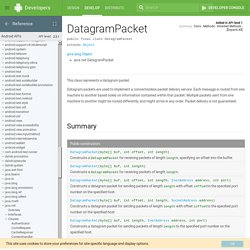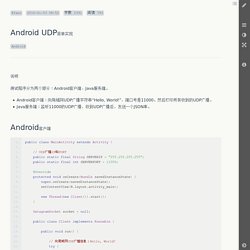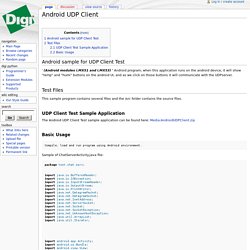

DatagramSocket. Public class DatagramSocket extends Object implements Closeable This class represents a socket for sending and receiving datagram packets.

A datagram socket is the sending or receiving point for a packet delivery service. Each packet sent or received on a datagram socket is individually addressed and routed. Multiple packets sent from one machine to another may be routed differently, and may arrive in any order. Where possible, a newly constructed DatagramSocket has the SO_BROADCAST socket option enabled so as to allow the transmission of broadcast datagrams. Example: DatagramSocket s = new DatagramSocket(null); s.bind(new InetSocketAddress(8888)); Which is equivalent to: DatagramSocket s = new DatagramSocket(8888); Both cases will create a DatagramSocket able to receive broadcasts on UDP port 8888. Summary Public constructors. DatagramPacket. Public final class DatagramPacket extends Object This class represents a datagram packet.

Datagram packets are used to implement a connectionless packet delivery service. Each message is routed from one machine to another based solely on information contained within that packet. Multiple packets sent from one machine to another might be routed differently, and might arrive in any order. Packet delivery is not guaranteed. Summary Public constructors DatagramPacket DatagramPacket (byte[] buf, int offset, int length) Constructs a DatagramPacket for receiving packets of length length, specifying an offset into the buffer. Android UDP简单实现 - 作业部落 Cmd Markdown 编辑阅读器. @Yano 2016-01-03 08:52 字数 2391 阅读 793 Android 测试程序分为两个部分:Android客户端、Java服务端。

Android客户端:向局域网UDP广播字符串“Hello, World!” ,端口号是11000。 然后打印所有收到的UDP广播。 AndroidManifest中添加Internet权限. Android UDP Client - Digi Developer. From Digi Developer Android sample for UDP Client Test ' (Android modules i.MX51 and i.MX53) ' Android program, when this application runs on the android device, it will show "temp" and "humi" buttons on the android UI, and as we click on those buttons it will communicate with the UDPserver.

Test Files This sample program contains several files and the /src folder contains the source files. UDP Client Test Sample Application The Android UDP Client Test sample application can be found here: Media:AndroidUDPClient.zip Basic Usage Compile, load and run program using Android environment. Android Socket範例 @ Joker-Android學習筆記. Android Socket範例 Socket介紹 有爬過一些文,了解當前的網路傳輸除了上一章的HTTP還有Socket的方式,而Socket可以分兩種 一種是連接的TCP應用服務,另一種是無連接的UDP應用服務 比較容易理解的說法是:TCP為打電話的方式(連接性)、UDP為發簡訊的方式(無連接性) 上一章的HTTP使用的是請求回應方式,表示當APP發出請求時建立連結通道,當客戶端向伺服器發送完請求,伺服器端才能向客戶端返回資料 而Socket的TCP/IP連線方式是雙方建立連結後可以直接進行資料的雙向傳輸,就不需要每次由客戶端向伺服器發送請求 而UDP連線方式提供無連接的資料傳輸,UDP在發送資料前不需建立連結,不對資料傳輸檢查,即可發送數據包 TCP協議的Socket連接: 伺服器端:

麝香貓的程式記事小本: [Android] UDP Receive / Send 完整-可執行-附檔案-教學. 花了兩三個禮拜終於把Android UDP搞定!
![麝香貓的程式記事小本: [Android] UDP Receive / Send 完整-可執行-附檔案-教學](http://cdn.pearltrees.com/s/pic/th/android-udp-receive-send-101155743)
首先,要先搞懂Thread / Handler是甚麼,不然這篇往下看沒有意義(因為會看不懂) 在MainActivity的部分,這邊負責主要的UI介面+Handler+Thread呼叫 package com.example.thread_example; import java.net.InetAddress; import java.net.NetworkInterface; import java.net.SocketException; import java.util.Enumeration; import android.annotation.SuppressLint; import android.net.wifi.WifiInfo; import android.os.Bundle; import android.os.Handler; import android.os.Message; import android.os.StrictMode; import android.support.v7.app.ActionBarActivity; import android.text.format.Time; import android.util.Log; import android.widget.TextView; @SuppressLint("NewApi") public class MainActivity extends ActionBarActivity { public static Handler exHandler; private TextView txv; private ChatServer chatserver; private ChatSender chatsender; public static InetAddress IP; public WifiInfo mwifiInfo; @Override protected void onCreate(Bundle savedInstanceState) { super.onCreate(savedInstanceState); setContentView(R.layout.activity_main); 這邊負責顯示WIFI的IP.
Android SDK 程式開發教學: [Android程式範例] android udp 廣播查詢特定主機. [Android] UDP 傳輸 - DatagramSocket « Kentpon's LogBook. 雖然標題是寫android 但是Android的UDP直接沿用java的 所以其實是java的UDP socket的使用 DatagramSocket datagramSocket = new DatagramSocket(); 雖然他的constructor 可以指定區網的 ip / port 但是為了避免你給到非法的 ip / port 大部分還是都讓他自己分配 而java的UDP傳輸得搭配對應的封包物件 DatagramPacket 用來發送封包要給定資料、資料長度、目標IP & port public DatagramPacket(byte[] data, int length, SocketAddress sockAddr) 拿來接收封包則可以拿到對方的給定資料、資料長度、目標 IP & port 注意 在執行發送和接收動作時不能在UI thread 不然就等著收Exception了 發送範例 try { DatagramSocket datagramSocket = new DatagramSocket(); byte[] data = "hello world!
![[Android] UDP 傳輸 - DatagramSocket « Kentpon's LogBook](http://cdn.pearltrees.com/s/pic/th/android-datagramsocket-kentpon-136479660)
". 接收範例 雖然UDP在傳輸資料時因為封包可以遺漏 所以傳輸速度很快 但是還是有Buffer Size的限制 datagramSocket.getReceiveBufferSize();datagramSocket.getSendBufferSize(); 操作上如果block太嚴重導致buffer滿了 你就會發現封包狂漏了 比較常出現的bug 就是你在收到一個封包後處理該封包時間太久 對方還是繼續狂傳 在你的receive buffer 滿了後就會看到 他怎麼傳怎麼漏 然後開始誣賴自己網路太差 當初自己有這種設計盲點被卡滿久的. 使用DatagramSocket发送、接收数据(Socket之UDP套接字) - jiangxinyu的专栏. 17.4.2 使用DatagramSocket发送、接收数据(1) Java使用DatagramSocket代表UDP协议的Socket,DatagramSocket本身只是码头,不维护状态,不能产生IO流,它的唯一作用就是接收和发送数据报,Java使用DatagramPacket来代表数据报,DatagramSocket接收和发送的数据都是通过DatagramPacket对象完成的。

先看一下DatagramSocket的构造器。 DatagramSocket():创建一个DatagramSocket实例,并将该对象绑定到本机默认IP地址、本机所有可用端口中随机选择的某个端口。 DatagramSocket(int prot):创建一个DatagramSocket实例,并将该对象绑定到本机默认IP地址、指定端口。 DatagramSocket(int port, InetAddress laddr):创建一个DatagramSocket实例,并将该对象绑定到指定IP地址、指定端口。 通过上面三个构造器中的任意一个构造器即可创建一个DatagramSocket实例,通常在创建服务器时,创建指定端口的DatagramSocket实例--这样保证其他客户端可以将数据发送到该服务器。 Receive(DatagramPacket p):从该DatagramSocket中接收数据报。 Send(DatagramPacket p):以该DatagramSocket对象向外发送数据报。 Android Socket UDP通訊. 在Android SDK撰寫Socket UDP,讓手機與各種裝置通訊摟!

在網路上搜尋Android的UDP通訊,看到很多文章都是失敗收場,甚至有些文章直接寫Android不支援UDP通訊協定,不死心的我決定要再來好好研究,果然皇天不付有心人,在零碎的資料整合後終於完成了Android的UDP程式了,以下就由我一步一步教大家怎麼做吧! 首先,必須要先釐清一個事情,不論在Windows的.Net平台或是Android SDK中,一個軟體在執行時就會產生一個程序(大陸叫進程,Process),一個程序中可以擁有多個執行緒(大陸叫線程,Thread),在程式的撰寫中,MAIN函數會在主執行緒中運作,連通使用者介面(UI)也被賦予在主執行緒中,然而,在寫通訊程式的時候會利用多執行緒的方式來撰寫,原因是主執行緒的工作是負責MAIN以及UI的運作,讓副執行緒運作一個不間斷且持續運作的迴圈,以便監聽通訊的工作,所以在這個範例中,我們會使用到Android的多執行緒寫作技巧。
在Android的多執行緒寫作技巧中,必須搭配其他技術才得以讓副執行緒去變更由主執行緒負責的UI,這個技術就是Handler,不過在本篇中我們專注在UDP通訊的部分,其他如Thread以及Handler將會另外新增篇幅來向大家說明,接著就進入主題吧! Java - DatagramPacket getData vs getLength. Sockets - How to obtain the actual packet size `byte[]` array in Java UDP. DatagramPacket (Java Platform SE 7 ) Java UDP通信(DatagramPacket类、DatagramSocket类、InetAddress类)(转) - 喔、勒勒. 一、DatagramPacket类: 如果把DatagramSocket比作创建的港口码头,那么DatagramPacket就是发送和接收数据的集装箱。

构造函数:一个用来接收数据,一个用来发送数据public DatagramPacket(byte[] buf,int length) //接收数据构造 DatagramPacket 用来接收长度为 ilength 的包。 Public DatagramPacket(byte[] buf,int length,InetAddress address,int port)构造数据报文包用来把长度为 ilength 的包传送到指定宿主的指定的端口号。 GetAddress() 返回接收或发送此数据报文的机器的 IP 地址。 GetData() 返回接收的数据或发送出的数据。 二、DatagramSocket类 此类表示用来发送和接收数据报包的套接字。 Receive(DatagramPacket p) 从此套接字接收数据报包。